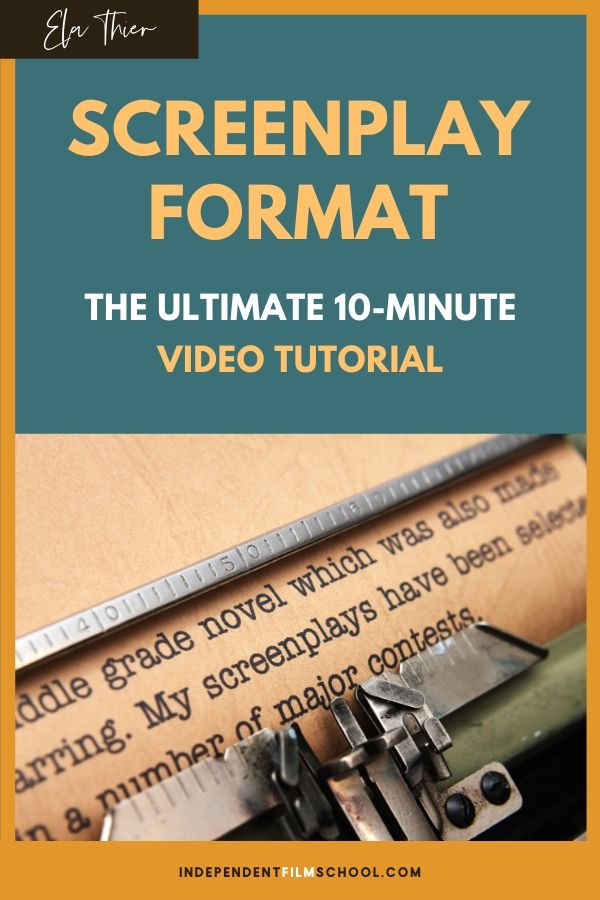
Three reasons to be a stick in the mud when it comes to Screenplay format
Listen, I’m all about creativity, but not when it comes to screenplay format. That’s where I draw the line. Were you around when we had antennas sticking out of our tube TV’s? Remember what it was like to see static on the screen? How annoying? No matter how good the show was, it was a drag to watch it with all those gray dots on the screen.
That’s you and your screenplay if you don’t format it properly.
Here are three reasons you should get seriously anal about screenplay format:
Reason #1: Your script won’t get read if it’s not properly formatted.
Imagine writing an incredible script that would touch lives in profound ways, but it never gets read – and therefore never gets produced – because right at the top of page 1 you put a period where there should have been a dash, or vice versa.
If you ever submitted a script to the Sundance Lab you know that in the first round they invite you to send in only the first five pages of your script.
Five pages is generous my friend. In reality, they know just by looking at page 1, without even reading it, if you know what you’re doing.
When you submit you script – anywhere – be it the Sundance Lab or a contest or an agent or a producer or an actor friend who you hope will be in it – all odds are against you.
So don’t let the formatting be the deterrent. Let readers judge you based on the content, not on how you present it. Only way to achieve that is by sticking to proper formatting.
Reason #2: Screenplay format is designed for visual storytelling.
Limitations almost always lead to greater creativity. What I love about this medium is that it forces you into the confines of only telling the reader what the audience sees or hears.
You can’t tell us how a room smells; you show us that it smells by how someone behaves when they walk in.
You can’t tell us what someone is thinking about; we hear what they’re thinking about because that’s the song we’ve seen them dance to when they were with their best friend when she was still alive.
The “rules and regulations” so to speak, of the format of writing a script, force you into writing that audio-visual experience rather than writing prose.
Said differently: master the format of script writing and the story telling will improve.
Reason #3: ScreenWRITING format is designed for production.
Get creative with the formatting and your producer, assistant director, art director, director of photography, cast members, the director themselves, and everyone else involved will curse you and the ground you walk in. (Ok, I get a little dramatic… but seriously.) Their work will be so much harder if you don’t properly format your screenplay.
The format of script writing is designed to quickly and easily turn a story into charts and graphs that tell everyone where they need to be, when they need to be there, and what the whole kit and caboodle is gonna cost them.
Unlike a novel, a screenplay is not a finished work in and of itself. A screenplay is a blueprint to help get you to a finished work: which is the film or show.
Proper screenplay format is designed to turn a work of heart wrenching art into excel sheets.
So don’t be the guy that makes all that harder than it needs to be ok? Ok.
The good news: Screenplay format is quick and easy to learn.
I just ask before you watch my 10-minute tutorial that you pay it respect. How?
Next time you write a script, stick to the format.
Don’t fudge where the period goes and where the dash goes. Don’t randomly add some space here and there in your scene headings or leave a space out. Don’t put in 4PM or August 1867 where you should be writing “DAY” or “NIGHT.” All that is static noise that will make it hard to read your story.
If I have your agreement to follow the format, then here goes. The video below goes over:
- The ABC’s for complete beginners
- Montages
- Text messages
- Dual language scenes
- And more…
I cover the details in a super easy-to-follow way.
It’s not rocket science, but it’s science. And if you write screenplays, I want the formatting of those first five pages to be so seamless that the reader doesn’t think about it because the formatting is invisible. The reader will only follow the story, see the movie you’re writing in their mind, and find themselves begging you for more.
Below this video: quick word on screenwriting software.
Before I continue, quick word from the sponsors (that’d be me…) I invite you to check out the courtesy trainings that I offer my members.
Is it screenwriting or script writing?
Totally interchangeable; they mean the same things.
That said: within the industry people talk about screenwriting not script writing. We use the word “script” mostly when it dangles by itself without the “writing” part. For example “I’m working on a script!,” or “My script will be ready …never.” Once you add the word writing in there it turns into screenwriting.
So you can talk about the format of “Script Writing” and you wouldn’t be wrong, but you might get called a freshman and get thrown into a locker (ouch). I say blend in and use the word screenwriting.
READ SCRIPTS!
After watching the 10-minute crash course, next step is to read a script or two. You don’t need to read hundreds of them (hello world-famous procrastination technique) but read one or two. Or three.
IndieFilmHustle has links to hundreds of downloadable scripts. Just saw their downloadable 2020 Oscar contenders. They’re all free.
Here’s IndieFilmHustle’s downloadable script library.
Just promise me not to spend more than 10 minutes choosing the one or two that you’ll read. Pick a script of a movie you’ve seen and loved that is in some way similar to the style and tone of the scripts that you write or would like to be writing. Go with that.
If you read more than one or two and still haven’t started to write your own, get back to my post on Overcoming Writing Blocks in 10 Minutes 🙂
Free or not, THE BEST SCREENWRITING SOFTWARE IS THE one YOU’RE USED TO.
I wrote many screenplays, for many years, long before screenwriting software existed. So I can tell you that it’s all bells and whistles.
The softwares out there all do the same thing. I use Final Draft because it was the only thing available when it first came out, and I was excited about not having to program macros into word documents to get the right margins (remember macros? It’s ok. Forget I said macros.)
Final Draft and Movie Magic are most commonly used within the industry, but they’re the pricier options. Fade In is more affordable.
Free ones are Trelby (for Windows) and Highland (for Mac). Celtx is no longer free, and some other “free” ones (like Causality) are free for a short, one-off project, but not if you write regularly (or plan to…)
Google “Best Screenwriting Software” and when you get crosseyed looking at that list of 9 or 10 or 12 “Best blah-di-blah” just pick one based on your budget and get on with your life.
They’re all the same.
I could put a link in here to some list or another with reviews and such, but these lists and the reviews change all the time. Best to google it and check out the most recently published list.
Do not, I repeat: DO NOT, let your search for the perfect software be the excuse to not be writing “yet.”
I wrote scripts for 15 years before screenwriting software existed. As long as you follow the format, you can write your next screenplay on a napkin.
Happy writing!

